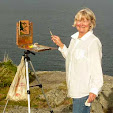On my last day in the city I visited a dozen galleries in Chelsea, and did I get an eyeful. As you can probably guess, much of what I saw was abstract, or at least abstracted. And there were several that caught my eye.
At the UNIX Gallery, I fell in love with "Something Surprising" by English artist William Bradley. I love the white negative space, the colors, and the composition in general. I was told that Bradley first mocks up his ideas in water color in a small format and then translates that onto the larger canvas.
William Bradley
Something Surprising
Oil on canvas
79 x 55 in | 201 x 140 cm
2016
At the Morgan Lehman Gallery I was intrigued by the work of Tim Bavington, whose current work is inspired by music. The vertical bands of color represent melody, beat, etc., in the particular piece of music, translating aural experiences into visual ones. The gallery has examples of both the initial watercolor on paper and larger synthetic polymer on canvas pieces as well as archival ink jet prints. I particularly enjoyed seeing the pieces where the artist had tested the synthetic polymer colors against the watercolor or ink piece.
Tim Bavington
Study for Highway 61 (Revisited)
Archival ink jet print with synthetic polymer
25 x 24 in | 63.5 x 60.96 cm
2017
2017
Courtesy of Tim Bavington and Morgan Lehman Gallery
Tim Bavington
Between the Lines of Age
Synthetic polymer on canvas
48 x 48 | 121.92 x 121.92 cm
2014
2014
At the Kim Foster Gallery I found a new twist on encaustic painting. Christian Faur uses crayons, pointy ends sticking out, to create beautiful large mosaic paintings. He uses the handmade crayons like pixels, arranging tens of thousands of them to create each painting. Think painting, Pointillism, and digital photography all rolled into one. There were other types of Faur's work in the exhibit, including portraits in a more classic encaustic style, though you could see the melted crayon shapes. I thought these were also fabulous.
Christian Faur
Peonies
43,680 hand cast encaustic crayons
20 panels, 55 x 69
2017
2017
Courtesy of Christian Faur and Kim Foster Gallery
While the finished work of each of these artists is compelling, it's the process that grabs my attention. And it's the process that makes them unique. When most of us think of process, we think of how the paint is applied, the steps used to create layers (or not), how the drawing is created on the support (or not), etc. But these artists are going one step further, or starting a few steps earlier, and using their medium in a new way (Faur's crayons), gathering inspiration and structure from an auditory experience (Bavington), or prototyping the work in a different medium (Bradley). We are probably more familiar with Bradley's approach, since many of us were taught do a value sketch before we paint. His was the first work to attract my attention (I won't tell you about all the paintings that didn't reach out to me AT ALL). And it was a great introduction to the more abstracted processes of the other two. Yes, I think you can abstract the process, not just the subject matter! I'm using abstracted here to describe the simplification of the process into a structural/design phase and an assembly phase. The brain work is in the design phase, though careful assembly is required. My little foray into abstract art in Chelsea has left me with a lot to think about as I continue the journey of abstraction in my own work.
While I usually show some of my own work in each blog post, I won't attempt that in this one. If you'd like to get a daily view of my work, take a look at my Instagram or Facebook page.
You can sign up to have posts on this blog emailed to you on the right hand side of this page.
And for periodic announcements, free art goodies, and special offers, sign up at the bottom of this page.






Hi Bobbi I just found you thru AHA. Do you know what synthetic polymer paint? Isn't that just acrylic?
ReplyDeleteHi Peter, synthetic polymer paints are acrylics, as you suspect. Sometimes museums use that term. Here's an interesting post from Golden Paints on the use of the term. https://www.goldenpaints.com/blog/2006/plastic-arts/acrylic-denial/
Delete